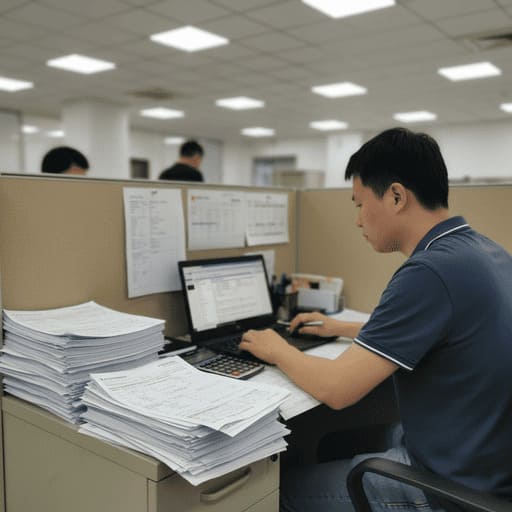Importing from China without proper customs clearance expertise can lead to seized shipments, hefty fines, and weeks of delays. Many businesses lose thousands of dollars when their products get stuck at the border due to incorrect documentation or classification errors.
Shipping services that handle customs clearance for imports from China to the US include integrated carriers (DHL, FedEx, UPS), freight forwarders (JojoShip China, China Freight Group, CMTrans), customs brokers, and 3PL providers. These services manage documentation, duty payments, and compliance with US import regulations.

In my years managing thousands of shipments from China to the US, I've seen how customs clearance can make or break an importing business. Let me walk you through the shipping services that can handle this critical process for you, based on my firsthand experience.
Do I Have To Pay Customs For A Package From China To The US?
Many importers are caught off guard by unexpected customs charges. Understanding when and how much you'll need to pay can prevent budget surprises and shipment delays.
Yes, you typically must pay customs duties for packages from China to the US valued over $800 (the de minimis threshold). Duty rates vary by product type (0-25% or higher), plus a processing fee of $2-10 for informal entries and $25-500 for formal entries. Commercial shipments require formal entry regardless of value.

Customs duties are an unavoidable part of importing from China to the US, but the exact requirements depend on several factors. Through my experience at JojoShip China, I've helped clients navigate these costs and requirements for years.
The first consideration is the de minimis threshold1. Currently, the US has an $800 de minimis value under Section 321, which means shipments valued under this amount generally enter duty-free. However, there are important limitations:
- This applies primarily to casual shipments and personal items
- Commercial shipments intended for resale may still require formal entry
- The $800 limit applies per shipment, not per item
- Certain products (like those subject to antidumping duties) are excluded
For shipments exceeding $800 or requiring formal entry, duties are calculated based on:
| Faktor | Description | Impact on Duties |
|---|---|---|
| HS Code2 | Harmonized System classification code | Determines duty rate (0-25%+) |
| Country of Origin | Where products were manufactured | Affects applicable tariffs |
| Declared Value | The fair market value of goods | Base for calculating duty amount |
| Special Programs | Trade agreements or exceptions | May reduce or eliminate duties |
Beyond the basic duty rates, importers should be aware of additional fees:
- Merchandise Processing Fee (MPF)3: 0.3464% of the shipment value (minimum $27.23, maximum $528.33)
- Harbor Maintenance Fee (HMF)4: 0.125% of the shipment value for ocean freight
- Single Entry Bond5: Typically $50-100 per shipment
- Continuous Entry Bond: Annual fee of $50-500 depending on import volume
One strategy I often recommend to my clients is considering Section 321 shipments for lower-value orders. By strategically breaking larger shipments into multiple packages under $800 each (when appropriate and legal), some importers can reduce their duty burden. However, this must be done carefully to avoid customs scrutiny for intentional splitting.
For commercial importers planning to bring in regular shipments, investing in a customs bond makes financial sense. A continuous bond6 covers all your entries for a year and often costs less than paying for multiple single-entry bonds.
At JojoShip China, we help clients understand exactly what customs costs they'll face and include these in our door-to-door quotes when requested. This transparency prevents the unpleasant surprise of unexpected charges that can derail your budget and business plans.
How To Do A Clearance When Buying From China?
The customs clearance process intimidates many importers, leading to costly mistakes or overreliance on expensive services. Understanding the process helps you make informed decisions.
To clear customs when buying from China: obtain an EIN/Tax ID, select the correct HS codes for your products, prepare accurate commercial documents (invoice, packing list, bill of lading), file an ISF for ocean shipments, pay duties and fees, and consider using a customs broker or freight forwarder for complex shipments.

Customs clearance is often the most complex part of importing from China, but breaking it down into manageable steps makes it less daunting. I've guided hundreds of businesses through this process and can share what works based on real experience.
The fundamental steps for customs clearance include:
-
Prepare Your Business for Importing:
- Obtain an EIN (Employer Identification Number) from the IRS
- Register for an Importer of Record number
- Consider getting a customs bond
-
Classify Your Products Correctly:
- Determine the proper HS (Harmonized System) code for each product7
- Research any special requirements for your specific products
- Check for antidumping or countervailing duties that may apply
-
Prepare Documentation:
- Commercial Invoice (with detailed description, quantity, value)
- Packing List (itemized contents with weights and measurements)
- Bill of Lading or Air Waybill
- Certificate of Origin (if applicable)
- Any product-specific certifications (FDA, FCC, etc.)
-
File Required Information:
- For ocean shipments: Importer Security Filing (ISF) 10+2, required 24 hours before vessel departure8
- Entry documents with CBP (Customs and Border Protection)
-
Pay Duties and Fees:
- Calculated based on classification, value, and origin
- Including MPF and HMF as applicable
-
Respond to Any Customs Inquiries:
- Be prepared for possible examination requests
- Provide additional information if requested
For most businesses, especially those new to importing or with complex products, working with a customs broker or freight forwarder with customs capabilities9 is the most efficient approach. At JojoShip, we've found that our clients save significant time and avoid costly mistakes by letting professionals handle the customs process.
Different product types face varying levels of scrutiny:
| Product Category | Risk Level | Special Requirements | Typical Clearance Time |
|---|---|---|---|
| General Consumer Goods | Low-Medium | Standard documentation | 2-5 days |
| Electronics | Mittel | FCC certification | 3-7 Tage |
| Food & Beverages | Hoch | FDA registration, prior notice10 | 5-14+ days |
| Textiles & Apparel | Mittel | Detailed fiber content | 3-7 Tage |
| Chemicals | Hoch | EPA, TSCA compliance | 7-14+ days |
One of the most common pitfalls I've seen is importers undervaluing their goods to reduce duties11. This practice carries serious risks, including penalties of up to 4x the duties owed, seizure of goods, and even being banned from importing. Customs officials are experienced at spotting undervaluation and routinely check market prices.
Another critical element is timing. For ocean shipments, the ISF filing must be completed 24 hours before the vessel departs China. Missing this deadline can result in penalties of $5,000 per violation. With air shipments, timing is tighter but still requires advance preparation.
When planning your import timeline, always factor in potential customs delays, especially during peak seasons or if your product requires special permits or inspections. Building this buffer into your supply chain planning can prevent disappointed customers and missed sales opportunities.
How To Ship Goods From China To The USA?
Navigating the complex shipping landscape between China and the USA overwhelms many businesses. Choosing the wrong shipping method can eat into profits and cause delivery delays.
To ship goods from China to the USA: select the appropriate shipping method (express, air, or sea freight based on size, value, and urgency), find a reliable freight forwarder or carrier, prepare proper documentation, ensure customs compliance, arrange insurance, track your shipment, and plan for domestic delivery after customs clearance.

Shipping goods from China to the USA efficiently requires strategic planning and understanding of the available options. After years of managing this trade route, I've developed a systematic approach that works consistently for businesses of all sizes.
The first critical decision is selecting the right shipping method based on your specific needs:
| Versandart | Am besten für | Transitzeit | Cost Range | Min/Max Size |
|---|---|---|---|---|
| Express-Kurier (DHL/FedEx/UPS) | Urgent, smaller shipments | 3-5 Tage | $5-15/kg | Up to 150kg |
| Luftfracht | Time-sensitive, mid-sized | 5-10 Tage | $3-8/kg | 150kg-500kg+ |
| Sea Freight (LCL) | Larger, less urgent | 25-40 Tage | $40-60/CBM + fees | 0.5-15 CBM |
| Sea Freight (FCL) | Volume shipments | 25-35 days | $3,000-10,000/container | 15+ CBM |
Once you've selected the appropriate shipping method, follow these steps to ensure a smooth process:
-
Find a Reliable Partner:
- Research freight forwarders with China-USA expertise12
- Verify their customs clearance capabilities
- Check reviews and ask for references
- Confirm they offer door-to-door service13 if needed
-
Prepare Your Products for Shipping:
- Ensure proper packaging for international transit14
- Label everything clearly with shipping marks
- Consider consolidation if shipping from multiple suppliers
-
Handle Documentation Thoroughly:
- Commercial Invoice with complete product descriptions15
- Detailed Packing List with weights and dimensions
- Bill of Lading or Air Waybill
- Certificates of Origin if needed
- Product-specific certifications (e.g., FDA, FCC)
-
Arrange for Insurance:
- Standard carrier liability is minimal (typically $2/kg)
- Comprehensive cargo insurance typically costs 0.3-0.5% of goods value
- Consider the risk level and value of your products
-
Plan for Customs Clearance:
- Determine who will handle customs (you, your forwarder, or a broker)
- Prepare for duty and tax payments16
- Understand timeline implications of customs processing
-
Coordinate Final Delivery:
- Provide accurate delivery address and contact information
- Consider access restrictions at the delivery location
- Plan for receiving and inspecting the shipment
For businesses new to importing from China, I strongly recommend starting with a full-service freight forwarder like JojoShip China that handles the entire process. This approach minimizes your learning curve and risk exposure while you build experience with international trade.
One important strategy is to build relationships with suppliers in China who can support your shipping process. I've found that suppliers with export experience can help with initial steps like preparing accurate commercial invoices and packing goods appropriately for international transit.
Another key consideration is seasonality17. Shipping costs and transit times can increase dramatically during peak seasons:
- Chinese New Year (January-February): Many factories and logistics providers shut down
- August-October: Peak holiday shipping season with limited space and higher rates
- December: Year-end rush can cause congestion and delays
Planning your inventory and production schedule around these predictable fluctuations can save significant costs and prevent delays. At JojoShip China, we typically advise clients to ship 2-4 weeks earlier than they might otherwise plan during these peak periods.
For businesses importing regularly, developing a standardized process for shipping and customs clearance pays dividends in efficiency and cost savings. This includes creating templates for required documents, maintaining accurate product databases with HS codes18, and establishing relationships with reliable partners on both ends of the supply chain.
Schlussfolgerung
Navigating customs clearance for China-US imports doesn't need to be overwhelming. Choose a shipping service with proven customs expertise, prepare accurate documentation, understand your duty obligations, and consider working with a specialized freight forwarder for the smoothest experience.
-
Understanding the de minimis threshold helps you know when shipments are duty-free, saving you money and avoiding unnecessary customs charges. ↩
-
Learning about HS Codes ensures you classify your products correctly, which directly impacts the duty rate and compliance with US customs. ↩
-
Knowing about the MPF helps you accurately estimate total import costs and avoid budget surprises when shipping goods from China. ↩
-
Understanding the HMF is crucial for importers using ocean freight, as it adds to your overall shipping expenses and affects profitability. ↩
-
Exploring Single Entry Bonds helps you determine the best way to secure your shipments and comply with US customs regulations. ↩
-
Learning about continuous bonds can save frequent importers money and streamline customs clearance for regular shipments. ↩
-
Correct HS code classification affects duties and compliance. This link will help you avoid costly mistakes and ensure your products are classified accurately. ↩
-
Filing ISF correctly and on time is crucial to avoid hefty penalties. This resource explains the process and requirements for compliance. ↩
-
A good broker or forwarder can save you time and money. This link will help you select the right partner for smooth customs clearance. ↩
-
If you import food or beverages, understanding FDA rules is vital. This resource covers registration and prior notice to ensure compliance. ↩
-
Learn why undervaluing goods is risky and how to avoid severe penalties, seizures, or bans from importing with this informative resource. ↩
-
Choosing a reliable freight forwarder with China-USA expertise ensures smooth customs clearance and efficient shipping, reducing risks and delays. ↩
-
Door-to-door service simplifies logistics by handling every step from pickup in China to delivery in the USA, saving you time and effort. ↩
-
Proper packaging protects your goods from damage during long-distance shipping, saving you money and ensuring customer satisfaction. ↩
-
A complete Commercial Invoice is essential for customs clearance and avoiding shipment delays or fines when importing goods. ↩
-
Understanding duty and tax payments helps you budget accurately and avoid unexpected costs when importing goods from China. ↩
-
Knowing how seasonality impacts shipping helps you plan ahead, avoid delays, and save on costs during peak periods. ↩
-
Accurate HS codes ensure correct customs classification, reducing the risk of delays, fines, or incorrect duty payments. ↩




